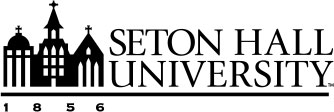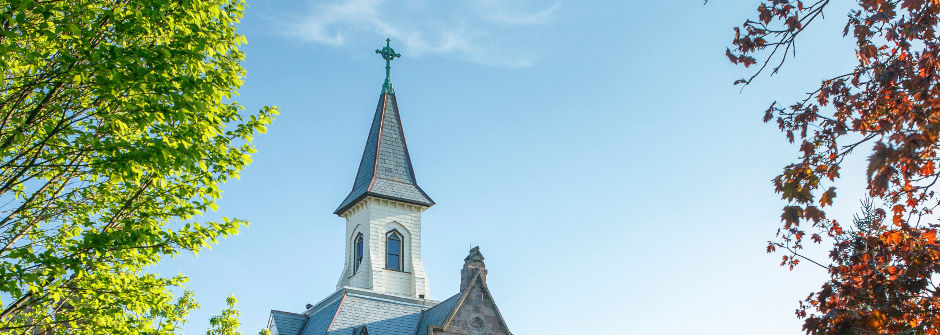
The Presidential Medallion
Saints, Monsters, Bishops, and Seton Hall: The Presidential Medallion
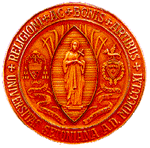
The Presidential Medallion, as inscribed on its reverse side, was "Presented to Right Reverend Monsignor John J. Dougherty by the Board of Trustees on his Inauguration as President April 25, 1960." John Joseph Dougherty served as President of Seton Hall University from 1959 to 1969. He was consecrated an auxiliary bishop of Newark in 1963 and died in 1986.
Struck by Herff Jones of Providence, Rhode Island, the medallion bears the original seal of Seton Hall as adopted by the Board of Trustees on May 17, 1864.
The inscription around the rim of the medallion reads: Universitas Setoniana A.D. MDCCCLXI, Religioni Ac Bonis Artibus, "Seton Hall University, A.D. 1861, For Religion and the Liberal Arts." The date indicates the year in which Seton Hall was chartered by the State of New Jersey to grant "the usual academic and other degrees granted by any other college in the state."
When Seton Hall became a university in 1950, the inscription on the seal was changed from Collegium Setoniense to Universitas Setoniana. This change provided an opportunity to correct an error in the Latin inscription. Setoniensis, -e is an adjectival form of the name Seton, but is a "locative" form used to refer to a place name, as if Seton were the name of the town in which the university was located. The correct form, the simple adjective Setonianus, -a, -um, was adopted to modify the now appropriate word Universitas. According to tradition, this correction was made by Rev. Joseph P. Christopher, Ph.D., then professor of Classical Languages at The Catholic University of America and later professor at Seton Hall.
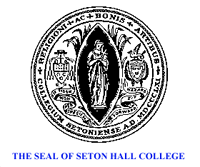
The center of our seal depicts a woman wearing a veil and holding a cross. According to early twentieth century descriptions of the seal, this represents "Our Lady Seat of Wisdom." If so, it is a rather unusual representation of the Blessed Virgin under this particular title. Usually Our Lady Seat of Wisdom is pictured, not surprisingly, as seated, and holding the Child Jesus on her lap. This is the form in which she is depicted on the medieval arms of several universities, such as Louvain. Among other representations of a woman holding a cross is that of St. Helena, mother of Emperor Constantine, who, according to tradition, discovered the relics of the cross of Christ. Another is the allegorical depiction of "Faith," who is shown as an unveiled woman holding a cross and a ciborium or a monstrance containing the Blessed Sacrament.
Placing the figure in a mandorla, a panel in the shape of an almond, indicates that the designers intended at least that the figure represent the Blessed Virgin. The mandorla frame was, in medieval architecture, reserved for the figures of Christ and the Blessed Virgin. This often is seen in statues and reliefs over the main entrance to cathedrals. Medieval heraldry followed the same pattern, with occasional exceptions being made for particular saints, usually the patron of the church or abbey represented by the coat of arms. In any event, we may presume that the figure in the Seton Hall arms is the Blessed Virgin Mary. If it was intended that this figure portray Our Lady Seat of Wisdom, it is an atypical version.
Behind the figure are what appear to be fronds or sheaves. They might well be sheaves of palm, representing Palm Sunday, which anticipated the Resurrection of Christ, or they may simply be decoration, given the Victorian aversion to leaving any empty space unfilled.
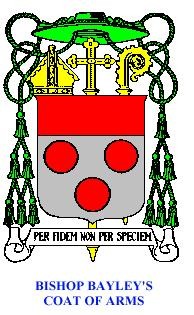
The shield bears the arms of the Bayley family, originally from Hoddeston, Hertfordshire, England. These arms are blazoned in a combination of archaic French and English: Argent, three torteaux - two and one, a chief gules. This translates as "A silver shield on which are three torteaux arranged two above one, the upper portion of the shield, the chief, in red." The torteau is a heraldic device of French origin representing a loaf of bread. Often it was bome by families whose origins as bakers it thereby indicated. The torteau is depicted on a shield as a flat red colored disc. On a scroll beneath the coat of arms is Bishop Bayley's motto, Per fidem non per speciem. This is taken from the Second Letter to the Corinthians, chapter 5, verse 6, and can be rendered "By faith not by sight."
Few, if any, Scottish coats of arms as old as that of the Setons. The earliest existing seal of the family is that of Sir Alexander de Seton which dates from 1216. In their original form, probably dating from the twelfth century, they are blazoned: Or, three crescents gules. This is interpreted: "A gold shield on which are three red crescents." The origin of the crescents is debated. Some maintain that they refer to the crescent-shaped harbors of three Sea Towns which were not only part of the ancestral lands of the family but the putative origin of their name. Others claim that the crescents were added after the Crusades to allude to victories over Islam in which the Setons played a role.
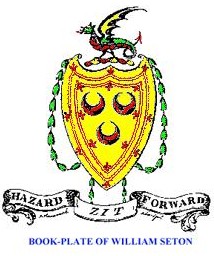
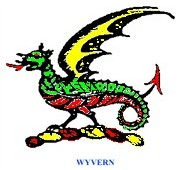
On a scroll below the shield is the family motto, Hazard Zit Forward. Like many of the oldest mottoes found in England and Scotland, it is a combination of Norman French and archaic English. The letter Z is actually an old English letter known as a yogh and pronounced as a Y. The meaning of the motto is: At whatever risk, yet go forward. In addition to the motto some of the early Seton arms carry the family war cry, Set on, an obvious play on the name. The shield is also adorned with a wreath-like decoration of no heraldic significance.
During the presidency of Bishop Dougherty this original seal and coat of arms was replaced by the current simplified arms which incorporated elements of the Bayley and Seton arms and altered the motto to Hazard Yet Forward, an acceptable and more comprehensible variant. William F. J. Ryan, an expert American heraldist, designed the new coat of arms. Ryan had designed hundreds of coats of arms for American prelates and Catholic institutions. The style he adopted followed an eclectic interpretation of British, rather than continental, heraldic regulations and traditions. He was free to do this as there are no laws in the United States regarding heraldic styles and forms. Nor is there any agreed upon American heraldic tradition.
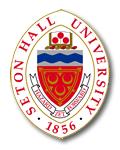
In order to create a coat of arms unique to Seton Hall, Ryan took the Seton arms as his base, reversed the colors, and added a device from the Newark archdiocesan arms. The blue wavy band which he placed on silver as the chief of the new shield represents one of the rivers which flows through the archdiocese of Newark. Ryan created an appropriate crest, an open book symbolic of university studies, on which he placed the red disks from the Bayley arms in a new arrangement. Unlike the nineteenth century arms, the current arms have the virtue of simplicity. Like the old version they represent the Seton Hall's origins and heritage, the Bayleys and the Setons, as well as its Catholic identity. These symbols are most evident when the arms are clearly and correctly portrayed.
Bibliography
J. P. Brooke-Little.Boutell's Heraldry, Frederick Warne: London, 1978.
Stephen Friar, ed.A Dictionary of Heraldry, Harmony Books: New York, 1987.
A.C. Fox-Davies.Complete Guide to Heraldry, Thomas Nelson and Sons: London, 1909, revised 1949.
Rodney Dennys.The Heraldic Imagination, Clarkson N. Potter, Inc: New York, 1975.
Ottfried Neubecker.Araldica: Origini, Simboli, Significato, Mondadori: Milan, 1980.
Records of the Meetings of the Board of Trustees of Seton Hall College, 1861-1935, Archives of Seton Hall University.
Robert Seton.An Old Family or The Setons of Scotland and America, Brentano's: New York, 1899.
Setonian, v. 8, n. 9, Diamond Jubilee Edition, June 4, 1941.
Eugene Zieber.Heraldry in America, Greenwich House: New York, 1895.
